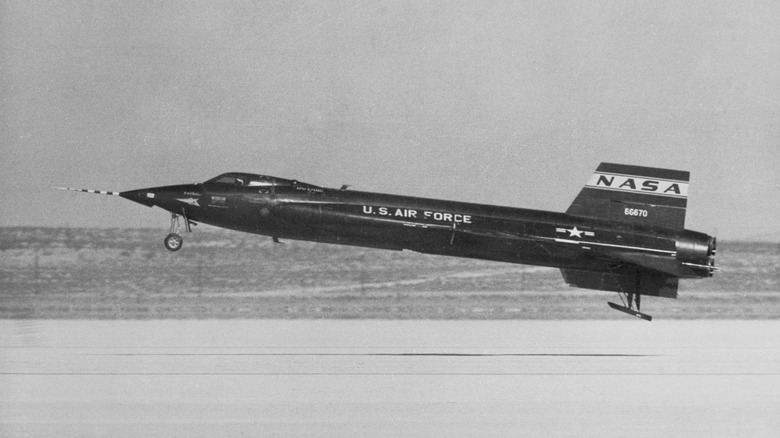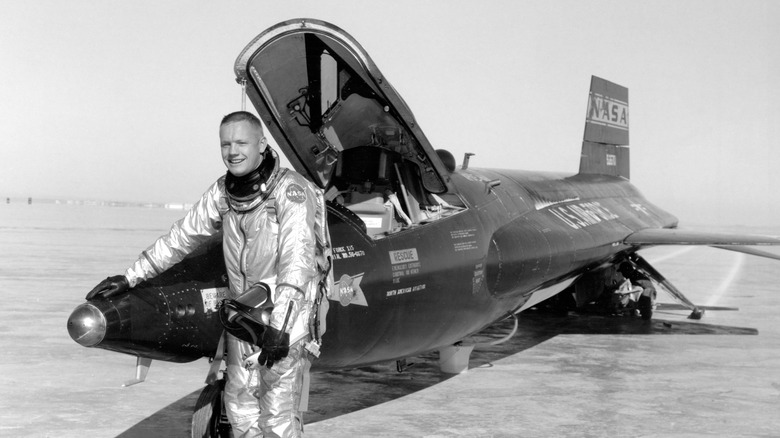The Unique Landing Technique Of The Fastest Manned Aircraft Ever Built
An aircraft capable of hitting 4,520 mph (nearly seven times the speed of sound) is ludicrous to even think about, but the North American X-15 achieved this, defying comparison to any other aircraft that has ever existed. Almost six decades later, the speed record that Pete Knight (one of the courageous pilots who stepped into the cockpit of the X-15) set in 1967 remains untouched.
The incredible X-15 was designed to reach hypersonic speeds (over Mach 5), but not sustain it for prolonged periods. The aircraft's dramatic flights, from launch to landing, would generally last around ten minutes. A specialized B-52 served as a base from which to launch, but the end of the flights were perhaps even more unique. This was when the experimental aircraft's landing gear, naturally, came into play, but there was another feature of the vessel's body that had to be moved out of the way first.
https://www.youtube.com/watch?v=_xUG5N9qDcY
The rather prominent fin on the underbelly of the aircraft had to be jettisoned when it came time to make a landing, parachuting to the ground. This was necessary because this fin was longer than the two skids that, in tandem with the landing gear beneath the nose, the aircraft relied upon once it touched down. Using this setup, the X-15 would essentially "ski" to a stop. The pilot couldn't steer the wheel at the front, either, meaning that landings could only be performed at dry lakes. The primary location chosen was California's Rogers Dry Lake.
The flight of the remarkable X-15
According to CNN, the X-15, the fastest jet ever recorded, "could start its approach at 20,000 feet and at supersonic speeds in excess of 1,500 mph." Every aspect of the X-15's design was built to take the strain caused by the ludicrous speeds it could reach, because at five or six times the speed of sound, there were tremendous dangers structure-wise. Another factor that contributes to the X-15's risks is how high it could fly. It reached heights of 354,200 feet, necessitating custom pressure suits to provide oxygen, manage the pressure experienced at such altitudes, and allow for communication for its pilots.
As for the aircraft itself, the most critical component was the engine. The XLR99 rocket engine, powered by ammonia and liquid oxygen, offered what amounted to approximately 500,000 horsepower. Strong metal alloys of titanium-manganese and nickel-chromium were employed in the skin and interior elements of the aircraft. All of this kept the vessel structurally sound at extreme heat and heights, with aluminum employed in the cockpit for further protection for those piloting this remarkable machine.
Pilots would take either high-altitude or high-speed flights in the X-15, which would allow for a better research focus on one or other of its primary talents. At heights, it was reliant on its reaction controls, which involved maneuvering via the thrust generated by small amounts of hydrogen peroxide. From there, it would begin to glide back to Earth, powered for only a brief time.
An unimaginable landing speed
The pilots who entered the cockpit of this astonishing aircraft, of which just three were made, were fully aware of the dangers. All 199 flights took place between 1958 and 1968, a time of incredible innovation, but nothing capable of such speeds had been designed before. Certainly nothing manned. Tragically, one X-15 pilot would pay the ultimate price. In 1962, pilot John McKay was seriously injured in a crash, and five years later, Michael Adams was killed when he couldn't right a control issue mid-flight.
Both men, however, will always be part of the proud legacy of one of the most astonishing stories in aviation, as will the other ten intrepid NASA and U.S. Air Force pilots who would fly the aircraft. Among them was a certain Neil Armstrong, who would fly it seven times. As Armstrong Flight Research Center historian Christian Gelzer put it to CNN, the X-15 "gave you the greatest speed, the greatest excitement, the greatest terror."
This machine was a seemingly impossible marvel of its time, but it was also incredibly problematic. If you're in the trade, you can imagine the sorts of nightmares that engineers had trying to equip this thing for the task before it: To teach NASA, the military, and North American aviation about the effects of absurdly fast hypersonic flight. As NASA puts it, the research aircraft was a vessel designed to "study high aerodynamic heating rates, stability and control, physiological phenomena, and other issues" relating to such. This naturally meant pushing to speeds above Mach 5 in the first place, which it certainly did.


